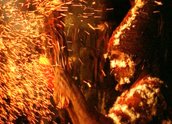


Blood Brothers – Jardiwarnpa (1993)
Synopsis
Jardiwarnpa documents the ceremonial dances of the Warlpiri over two weeks, with minimal intrusion by the film crew, who capture the unfolding ceremony. It is an observational style documentary periodically interrupted with a subject speaking to camera or in voice-over. Jardiwarnpa has an anthropological feel, which can perhaps be attributed to the film’s researcher and writer Marcia Langton, a well-known Aboriginal anthropologist.
Curator’s notes
Jardiwarnpa is the fourth episode of the Blood Brothers series produced by Ned Lander and Rachel Perkins for SBS Television. All episodes in the series deal with a different aspect of Aboriginal identity and cultural practice. This is the final installation in the series and deals specifically with traditional ceremony. Jardiwarnpa is made in collaboration with senior Warlpiri Kirda and Kurdungurlu, a dynamic reflected in the documentary style and technique. Written by Marcia Langton, a respected authority on Indigenous culture and Aboriginal representation, the distance between the filmmakers and the Aboriginal subjects is mindfully respected, and cultural protocols observed.
Jardiwarnpa is an example of the films being generated by Indigenous elders in their attempt to pass on traditions to the younger generations. The prevalence of Western culture is a threat to the ancient traditions of the Warlpiri, and without the ceremonies being performed, the land becomes sad. Land is central to all Indigenous customs and cosmology and the importance of ceremonial tradition is primary in sustaining the ongoing relationship between Indigenous peoples and the land.
The Warlpiri invite outsiders to observe the ancient ceremonies passed on to them by the Ancestors or Creator Beings. The orchestration of the ceremonies in the film challenge the concept of Indigenous culture as stagnant. The coaching of the performers as they participate in the ritual is an important observation. The elders moving alongside the performers, shouting instructions at them, is a revelatory moment for it shows Indigenous cultural practice as being emergent, evolutionary, and marked by constant change and improvement. The dominant view that Indigenous culture as non-changing is disrupted by these scenes, and instead, Indigenous cultural practice is presented as vibrant and living, and both intense and intentional.
- Overview
- Curator’s notes
- Video 3 clips

- Principal credits
- Find a copy
- Make a comment
- Map
- Add your review



